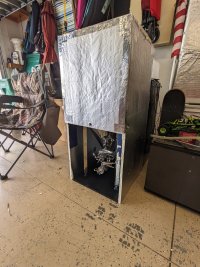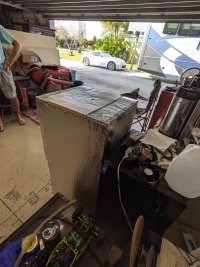I am building a chiller for my 17 Gal conical fermentor. It seems that most DIY builds involve chilling a thermal glycol/water reservoir to something well below target fermentation temperature, and then cycling flow of the coolant through the fermentor when needed. I would think a better approach is to cycle the cooling fluid continually, and chill the water/glycol source as needed to maintain the fermentation target temp (thereby, keeping the reservoir temp close to the target fermentation temp).
I base this on several factors. One being that the latter method will operate with much a lower temperature differential across the entire system. The advantages would be:
I am expecting the cooling coils in the fermentor to have at least 10X to 100X better thermal conductivity than the heat absorbed by the conical through the insulated jacket, so I would expect little variation between the wort temp vs the continuously circulated coolant temp.
I have also seen posts that suggest a 5000 BTU A/C is better suited to the task than a mini-fridge - which has me baffled considering that the A/C unit has the capacity to chill a half BBL fermentor more than 40 degrees F in one hour (excessive in my opinion - I can tolerate about 1/10 that rate) !!!???
If anyone has experimented or has data to clarify any of this, I would appreciate the info.
I plan to run a few experiments next week trying to quantify the heat absorption through the fermentor jacket, the cooling rate of a mini-fridge on a reservoir, and the ability of continuous circulation to maintain a set temp within the fermentor.
I base this on several factors. One being that the latter method will operate with much a lower temperature differential across the entire system. The advantages would be:
* Less thermal loss and better overall efficiency
* Less temperature variation inside the fermentor due to:
* Coolant is closer in temperature to the wort temp
* Flow is continuous, not sporadic
* Less temperature gradients within the wort (since the wort isn't moving, large temp differentials and low duty cycle would cause more gradients since the coil is super cool but for less time)
* Total heat transfer for a continuous duty cycle requires less mass in the cooling source (Q ∝ P*t)
* Air transfer in the fridge is more efficient when running continuously, compared to trying to maintain a super-cooled reservoir, where you need faster chilling of the reservoir.
I am expecting the cooling coils in the fermentor to have at least 10X to 100X better thermal conductivity than the heat absorbed by the conical through the insulated jacket, so I would expect little variation between the wort temp vs the continuously circulated coolant temp.
I have also seen posts that suggest a 5000 BTU A/C is better suited to the task than a mini-fridge - which has me baffled considering that the A/C unit has the capacity to chill a half BBL fermentor more than 40 degrees F in one hour (excessive in my opinion - I can tolerate about 1/10 that rate) !!!???
If anyone has experimented or has data to clarify any of this, I would appreciate the info.
I plan to run a few experiments next week trying to quantify the heat absorption through the fermentor jacket, the cooling rate of a mini-fridge on a reservoir, and the ability of continuous circulation to maintain a set temp within the fermentor.




